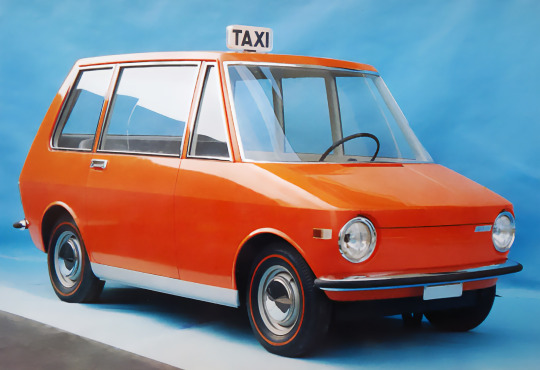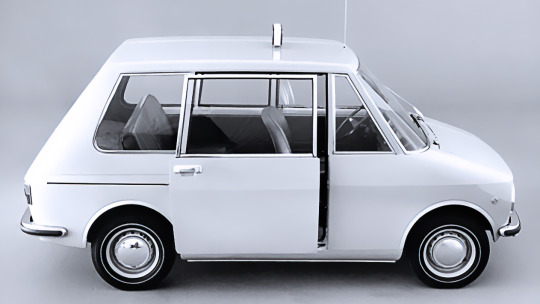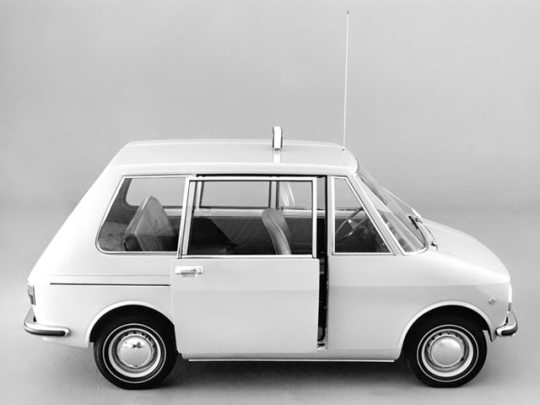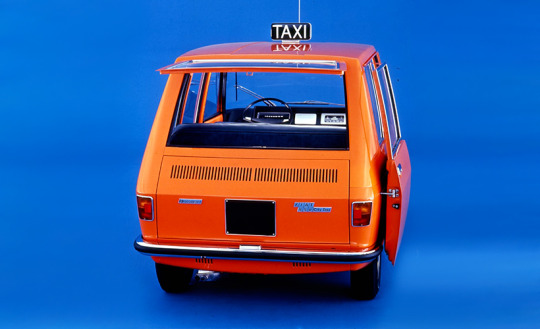#Fiat 850 City Taxi
Text






Fiat 850 City Taxi Concept, 1968. Fiat's head engineer Dante Giacosa commissioned Pio Manzù to design this compact prototype for a taxi with “limited external dimensions, accessibility, visibility, manageability, security and recognisability”. The prototype which was built in 1968 and exhibited at the Turin Motor Show had one long sliding door on the right and a normal opening door for the driver on the left. It could seat three passengers and carry their luggage (where the front passenger's seat would have been) but was a mere 3.2 metres long.
#Fiat#Fiat 850#Fiat 850 City Taxi#Pio Manzù#rear engine#concept#design study#1968#Turin Motor Show#prototype#taxi concept#taxi#cab
313 notes
·
View notes
Text



1968 Fiat 850 City Taxi Concept
My tumblr-blogs:
www.tumblr.com/germancarssince1946 & www.tumblr.com/frenchcarssince1946 & www.tumblr.com/englishcarssince1946 & www.tumblr.com/italiancarssince1946 & www.tumblr.com/japanesecarssince1947 & www.tumblr.com/uscarssince1935
9 notes
·
View notes
Text

Fiat 850 City Taxi prototipo, Salone di Torino, 1968
17 notes
·
View notes
Photo

1968 Fiat City Taxi Prototype #Fiat #FiatCityTaxi #Prototype #StoryCars #ConceptCars https://www.story-cars.com/post/1968-fiat-850-special-grand-prix-by-francis-lombardi
1 note
·
View note
Photo

Today on OldMotors.net (link in bio) we’re looking back at the history of the Fiat 127. This landmark small car was not sold in the USA, so there isn’t much of an “American perspective” on it, but it was arguably the first modern supermini, arriving one year before the Renault R5 and Mk1 Honda Civic. It was the work of Dante Giacosa, and the last full design he supervised, having retired in early 1970. But underneath, there was much more going on. The 127 was developed in concert with the Fiat 128 and Autobianchi A112 that came before it, both being released in late 1969. All three were outgrowths of the Autobianchi Primula, a design Giacosa and Ettore Cordiano had created in the wake of the market impact of BMC’s mini. Giacosa had designed a transverse-engined front-driver as early as 1947, but couldn’t figure out how to build a reliable or cheap-to-make production version of his prototype. As soon as the Mini dropped, he regretted not having investigated it further. That led to his front-drive explorations with Cordiano, agreed to only with grudging permission from Fiat’s second-in-command Gaudenzio Bono. The front-drive idea proved fruitful, and reached production as the Primula, sold as an Autobianchi to help boost that flagging brand and also prevent any damage to Fiat if the idea soured. It turned out that the Primula worked very well, and the race was then on to create proper replacements for the 1100 and 850 out of it. Those cars were the first wave of Fiat’s “X” designs, the X1/1 being the 128, the X1/2 the A112, and the X1/4 the 127. (The X1/3 was the big 130. Original the A112 was to be a Fiat, but Bono decided that Fiat should have something sized between the Mini-fighting A112 and the ADO16-sized 128, and thus was born the 127. Giacosa had hired Pio Manzù as a design consultant almost fresh out of school, but the talented Manzù was charged with designing the exterior of the 127 after proving his mettle with the Fiat 850-based City Taxi concept of 1968. Alas, Manzù did not live to see the 127’s huge success. Fiat sold its 1,000,000th 127 in 1974. Want to know more? VISIT THE WEBSITE! https://www.instagram.com/p/CL2d4hGlwMq/?igshid=173cpme1vl7so
1 note
·
View note
Text
SEAT

It all began in Spain in the post-war period in 1950, when it was to encourage the consumption of cars and develop the country's automobile industry (at that time there were 3.1 cars per 1,000 inhabitants), the state-owned National Institute of Industry (INI) , with the close collaboration of Fiat, founded the Spanish Society of Automobiles for Tourism on 9 May. The establishment of a Spanish carmaker was of extreme importance for the country, since it stimulated the growth and development of the industry: small producers of parts and components no longer needed to export their products.
Three years later, the new company opened a factory in the Barcelona free zone, producing its first car, called the SEAT 1400, an elegant and spacious model destined for the luxury market, being ideal to be used as a taxi and offered in a wide range of versions . With a daily production of five vehicles, the great demand demanded that there was a large stock. On June 27, 1957 began production of the SEAT 600, a response to the growing demand for a car more economical and accessible to the emerging Spanish middle class. With this model also begins the era of massive motorization, with the SEAT 600 becoming the Spanish symbol of mobility and freedom, often called "pellet" (small ball). Soon after came the SEAT 800, being considered the most significant model of the brand for having achieved great acceptance in the Spanish middle class.
The first exports happened in 1965, when a few units of their cars were shipped to Colombia. The following year, the 850 model, which shared the same mechanical base as the SEAT 600, came on the market, but offered more space and comfort, as well as better performance. This model was the first vehicle to offer a wide variety of versions - including a sporty, four-door and adaptable. Shortly thereafter, in 1968, the production of automobiles reached the impressive mark of 1 million units. In 1973 the construction of the technical center began in Martorell, metropolitan area of Barcelona, which became operational two years later.
Despite this, the euphoria of SEAT's rapid growth was interrupted for a time by the unexpected shock of the 1973 and 1977 energy crisis and General Franco's death in 1975, which caused profound changes in the Spanish political structure. At the end of this decade, in 1979, the presentation of the SEAT RITMO, an innovative and versatile vehicle, determined the way SEAT's design should be during the 1980s. The 1980s began with the signing of industrial and operating with Volkswagen in 1982. With this, the technology and design of the cars of the Spanish automaker have evolved in a frightening way. From this moment, SEAT cars began to be recognized in the European market due to its Mediterranean design combined with the efficient German technology.
Shortly after, in 1984, the company introduced the IBIZA model, one of its greatest commercial successes. In the year 1986 Volkswagen acquired approximately 75% of the shares of the Spanish automaker. It was in that same year that exports began to Europe, with the Netherlands receiving the first models of the Spanish brand. Also this year was created the sport division of the company, known as SEAT SPORT. In 1990 Volkswagen increased its shareholding in the company to 99.99% and officially changed its name to SEAT S.A. (an abbreviation of Spanish Society of Tourism Automobiles). The following year TOLEDO was launched, the first model developed within the Volkswagen group. On November 22, 1993 the factory of Martorell was inaugurated by King Juan Carlos I of Spain. Thus, in 1995, the SEAT number of 10 million was produced.
The following year, in addition to winning the world rally title with an IBIZA model, which earned him great international acceptance, he presented his first mini-van, a model called ALHAMBRA, to the market. With the arrival of the new millennium, the company decided to reposition SEAT as a sports brand, being integrated into the group of sports brands of the Volkswagen Group, which also includes Audi and Lamborghini. As a result, in 2002 SEAT and Audi began to promote joint design, research and development management, using shared assembly lines, thus providing greater coverage of the market segments. In addition, the slogan "SEAT. Auto emoción ", reflected the values of the brand including the design and the sporting character.
The year 2012 was marked by great news and many changes. They started with the brand's new visual identity and a new slogan. In addition, its range of models has been expanded and renewed with the launch of the tiny SEAT Mii, which with its 3.56 meters in length, numerous possibilities of customization and jovial design is an ideal model for large cities. SEAT also adopted a new positioning. When you sit behind the wheel of a car of the Spanish brand, you do not just start a journey. Start an experiment. An experience that captures the imagination and touches the emotions. This is the essence of ENJOYNEERING, which the consumer will find in all new models that use the SEAT logo, including the Ecomotive and E-Ecomotive line of environmentally friendly cars. It is the philosophy behind everything the brand does, guiding it in the development of new and innovative concepts in the future.
0 notes
Photo

1968 Fiat City Taxi Prototype #Fiat #FiatCityTaxi #Prototype #StoryCars #ConceptCars https://www.story-cars.com/post/1968-fiat-850-special-grand-prix-by-francis-lombardi
0 notes
Photo

1968 Fiat City Taxi Prototype #Fiat #FiatCityTaxi #Prototype #StoryCars #ConceptCars https://www.story-cars.com/post/1968-fiat-850-special-grand-prix-by-francis-lombardi
0 notes
Photo

1968 Fiat City Taxi Prototype #Fiat #FiatCityTaxi #Prototype #StoryCars #ConceptCars https://www.story-cars.com/post/1968-fiat-850-special-grand-prix-by-francis-lombardi
0 notes
Photo

1968 Fiat City Taxi Prototype #Fiat #FiatCityTaxi #Prototype #StoryCars #ConceptCars https://www.story-cars.com/post/1968-fiat-850-special-grand-prix-by-francis-lombardi
0 notes
Photo

1968 Fiat City Taxi Prototype #Fiat #FiatCityTaxi #Prototype #StoryCars #ConceptCars https://www.story-cars.com/post/1968-fiat-850-special-grand-prix-by-francis-lombardi
0 notes
Photo

1968 Fiat City Taxi Prototype #Fiat #FiatCityTaxi #Prototype #StoryCars #ConceptCars https://www.story-cars.com/post/1968-fiat-850-special-grand-prix-by-francis-lombardi
0 notes



